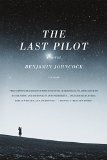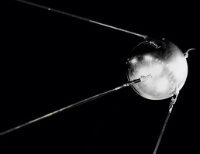Summary | Excerpt | Reading Guide | Reviews | Beyond the Book | Read-Alikes | Genres & Themes | Author Bio

Critics' Opinion:
Readers' Opinion:
First Published:
Jul 2015, 320 pages
Paperback:
May 2016, 320 pages
 Book Reviewed by:
Book Reviewed by:
Kim Kovacs
Buy This Book
This article relates to The Last Pilot
Much of The Last Pilot revolves around the United States' participation in the technological contest between the US and the Soviet Union involving conquests in outer space.
The Space Race had its origins in Nazi Germany prior to the outbreak of World War II. Military scientists and engineers designed ballistic missiles and liquid-fueled rockets, both of which were made to carry warheads longer distances than previously thought possible. At the war's conclusion, the technology and the scientific experts ended up in the United States and the USSR, thereby boosting these countries' weapons programs, escalating the conflict that became known as The Cold War.
 Although both countries were concentrating on designing rockets that could reach space, United States' military intelligence agencies really didn't know how far along the Soviets were in developing the technology. A Newsweek article stated that a 1957 meeting between Soviet and U.S. scientists left the Americans feeling smugly superior and believing that a Russian launch date was quite distant – only to be informed that very night that the Russians had launched Sputnik ("Traveler"), the first man-made object put into Earth's orbit. The 184-pound, 22.5 square-inch sphere traveled around the planet every 96 minutes transmitting radio signals, and its launch caught the U.S. military by surprise.
Although both countries were concentrating on designing rockets that could reach space, United States' military intelligence agencies really didn't know how far along the Soviets were in developing the technology. A Newsweek article stated that a 1957 meeting between Soviet and U.S. scientists left the Americans feeling smugly superior and believing that a Russian launch date was quite distant – only to be informed that very night that the Russians had launched Sputnik ("Traveler"), the first man-made object put into Earth's orbit. The 184-pound, 22.5 square-inch sphere traveled around the planet every 96 minutes transmitting radio signals, and its launch caught the U.S. military by surprise.
The fact that the Soviet Union had put a satellite in orbit caused a certain amount of hysteria among the American public - fueled by the emerging medium of television, which covered the Soviet efforts in detail. Images of the USSR dropping nuclear bombs on a vulnerable U.S. population ran through many minds, as did the idea that U.S. citizens could be unwitting subjects of Russian surveillance at any time. This was not helped by the United States' own attempt to launch a satellite later that year, which crashed and exploded into a huge fireball on the launching platform and caused the Russian Premier Khrushchev to remark, "America sleeps under a Soviet moon."
The United States successfully got its own satellite into orbit in 1958. Named "Explorer," it was designed by the U.S. Army under the direction of German scientist Wernher von Braun. The Soviets quickly trumped the accomplishment with the launch of the Luna 2, the first space probe to reach the moon. In response to Soviet successes, President Eisenhower signed a public order creating the National Aeronautics and Space Administration (NASA), a federal agency dedicated to space exploration.
Soviet cosmonaut Yuri Gagarin became the first man to orbit Earth in April 1961, followed into space by USA's astronaut Alan Shepard on May 5 (although he didn't orbit; that task was accomplished by John Glenn in February 1962). Later in May 1961, President John F. Kennedy made a speech claiming that the United States would land a man on the moon by the end of the decade, a statement that stunned and energized the public toward a common goal.
Interestingly, many of the plans prepared by the U.S. military focused on how the moon could be used in warfare, including the possibility of building nuclear reactors on it. Large nuclear explosions on or near the moon to trigger "moonquakes" were proposed, partly to study seismic activity in space and partly to prove that they could do something of that magnitude (a show of force, of sorts). Project Horizon, a detailed plan to establish a lunar outpost with a 12-member military staff on base by November 1966, was eventually deemed prohibitively expensive with a forecasted cost of $6 billion.
The United States declared victory in the Space Race on July 20, 1969 when astronaut Neil Armstrong became the first man to walk on the moon as part of the Apollo 11 mission. The Soviets subsequently made four attempts to launch a lunar landing craft between 1969 and 1972, none of which was successful.
To learn about the American Shuttle program, read the Beyond the Book for Losing Orbit.
Picture of Sputnink from NASA
Filed under People, Eras & Events
![]() This "beyond the book article" relates to The Last Pilot. It originally ran in August 2015 and has been updated for the
May 2016 paperback edition.
Go to magazine.
This "beyond the book article" relates to The Last Pilot. It originally ran in August 2015 and has been updated for the
May 2016 paperback edition.
Go to magazine.





The Funeral Cryer by Wenyan Lu
Debut novelist Wenyan Lu brings us this witty yet profound story about one woman's midlife reawakening in contemporary rural China.
Your guide toexceptional books
BookBrowse seeks out and recommends the best in contemporary fiction and nonfiction—books that not only engage and entertain but also deepen our understanding of ourselves and the world around us.